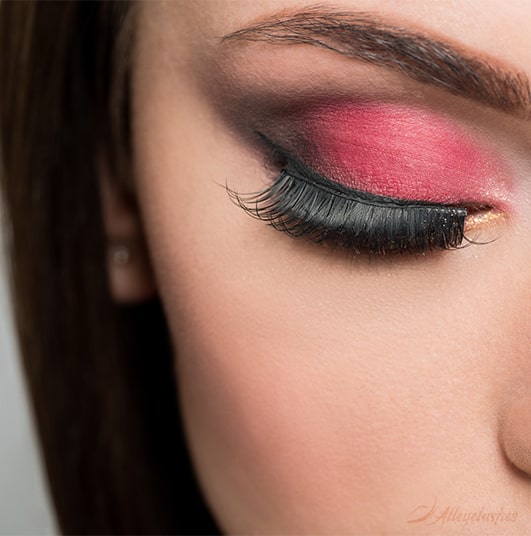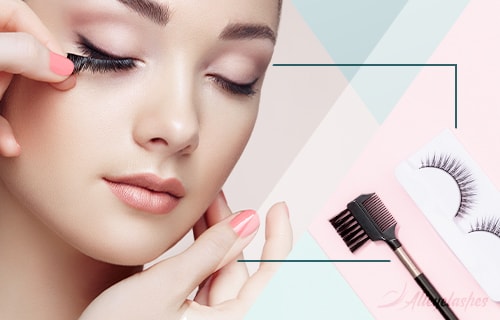False eyelashes are a great way to change up your look. You can go from casual to glam in no time flat. They grace the eyes of some of Hollywood’s most gorgeous celebs, including Nicki Minaj, Scarlett Johansson, and Angelina Jolie.
False eyelashes have become commonplace in the beauty world. They’re an accessory that’s affordable, fun, and easy to apply. However, false eyelashes do have some drawbacks.
Despite their popularity, experts note there are some growing concerns. After all, falsies outline one of the most sensitive body parts – the eyes. The eyes are not only the windows to the soul; they are an essential part of how we observe and process the world. Taking care of them is critical to our overall health and well-being. Improper use of falsies can result in a variety of unwanted side effects, including rash, irritation, and swelling.
To avoid this scenario, be sure to observe a few simple rules and techniques. Abiding by best practices in eyelash care will make your eyelash experience one that is safe and comfortable. In this article, we’ll outline some of the key reasons you should be careful and how you can steer clear of pitfalls and problems.


Why Do We Have Eyelashes in the First Place?
Eyelashes have a critical purpose. They are part and parcel of excellent eye health. They function as filters, keeping out dangerous particles and debris. Eyelashes also shield the sensitive parts of your eyes from the harsh sun. Eyelashes boast a unique curved shape that is not only gorgeous but serves an essential task.
The curved surface works as an aqueduct, moving moisture away from the eyes. They are an excellent way to detect objects that move too close. Things like bugs, flying dust, and the like are surefire ways for the eye to get any number of infections if they hit its delicate surface. Fortunately, the eyelashes are the first line of defense against these pesky invaders. They induce the blinking reflex.
This reflex keeps out irritants and other annoyances while ensuring that your eyes stay moisturized and healthy. Lashes typically have three significant growth periods. These periods include an active period of robust growth, a slow cessation of activity, and then finally, a resting stage. These cycles occur throughout the year, allowing your lashes to fully develop.
The Risks of Using Falsies Everyday
Although eyelashes serve a practical purpose, it’s often fun to enhance and play with their versatile nature. Falsies provide an affordable and creative way to transform your look. They come in a variety of lengths, volumes, and curl patterns. They are even available in different colors, and some have ornate embellishments. But be mindful that there are some health dangers associated with this accessory.
Glues and Adhesives
Attaching falsies is a simple process. However, the methods used include glues and other adhesives. Many adhesives can cause irreparable damage to the eyelash bed. Chemicals in the adhesives such as formaldehyde can destroy the skin around a lash follicle and irritate the skin around the entire eye as well. Formaldehyde is also a carcinogen, meaning it is cancer-causing. There is also an increased risk of getting the glue inside your eye. If glue gets into the structure of your eye, it can cause a severe reaction, including pain, itching, and swelling.
Tugging and Pulling
After a night out, many who wear false eyelashes may be too tired to detach their falsies properly. It’s often easy to fall into the trap of pulling and tugging at a strip only to irritate the skin and pull off the natural eyelash along with the false eyelashes. Too much tugging and pulling can cause excessive eyelash loss over time. It can also create a condition called “traction alopecia.” Traction alopecia is hair loss that is the result of the weight and strain of eyelash extensions on the natural hair shaft. Traction alopecia is also a risk for those that wear extensions with elaborate accessories such as beads, pearls, or crystals. The weight of these adornments on the lash line can cause pain and possible infection.
Dirt and Germs
Our natural eyelashes are great at keeping out debris and oils. Good hygiene combined with the dirt-trapping power of lashes can keep the dirt, germs, and bacteria at bay. They can ultimately keep our eyes feeling nice and healthy. False eyelashes can increase the risk of dirt and debris getting trapped beneath the lash line. Glues, makeup, oil, and germs can clog pores and infiltrate the lashes. Without general upkeep, false eyelashes can become a breeding ground for infection and disease.
Allergies
If you’re allergic to animal fur, be careful when buying lashes. False eyelashes are available in an array of materials, including silk, synthetic, and mink. Although mink offers the most realistic look, it can set off a flurry of allergic reactions.
Keeping Your Eyes Healthy
Although there may be risks to wearing falsies, with proper care and observation, you can still have excellent eye health and the look you love. Avoiding damaging effects and reactions can be as simple as implementing a few habits and techniques. Tips and Tricks:
- Find a formaldehyde-free adhesive: Formaldehyde-free glues are available for sale online and in stores. You can find bargains on a variety of brands that won’t break the bank.
- Keep your eyelashes secured in a cool, dry place and an airtight container: Storing your eyelashes properly will discourage the growth of molds and bacteria.
- Wash your falsies: Makeup and dirt are magnets for microbes. Avoid possible infections by gently removing makeup, dirt, and oils with cotton balls dipped in alcohol-based makeup removers. Swipe from band to tip and follow up with cotton balls dipped in warm water. Lay your falsies on a layer of absorbent paper towels to dry.
- Remove your falsies with care: Tugging roughly and pulling at your falsies can result in problems down the line. To remove your falsies properly, dip a few cotton balls in makeup remover to dissolve glue or adhesives. Gently pull the loosened strip away from your eyes.
- Be mindful of animal allergies: Most reputable companies detail the materials their lashes contain. Look at the labels carefully. If you have any animal allergies, it may be best to stick to lashes made of silk or synthetic materials.
- Don’t sleep in your lashes: After work or a night out with friends, it may seem harmless to get some shut-eye without removing those lashes. However, the weight of the lashes plus the stress of laying on them can cause you to lose your natural lash. You also set yourself up for a build-up of grime and dirt, which can lead to an infection.
- Don’t share lashes. EVER: What’s a little lash between friends? Well, it can mean the difference between having a good day and having an infection. Our bodies are all different, but we share one common trait: We harbor germs. What is harmless to one person can set off an intense reaction in another. To avoid cross-contaminating yourself and those you know, keep to your own set of lashes.
Wearing false eyelashes is fun and exciting. They enhance any makeup look along with giving volume and fullness. However, they also can come with a few risks. Many of these risks can include infection, swelling, irritation, and in extreme cases, blindness. To avoid these effects, observe proper cleaning and storage techniques, good hygiene, and be mindful of possible damage to your natural lashes.








